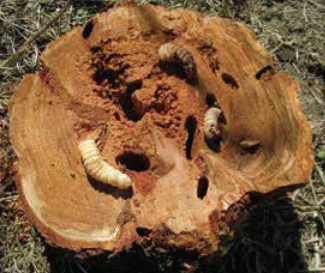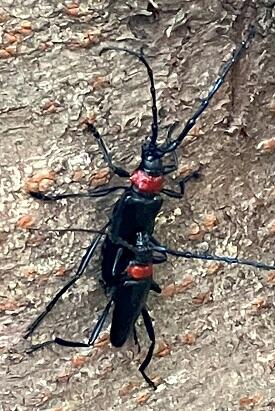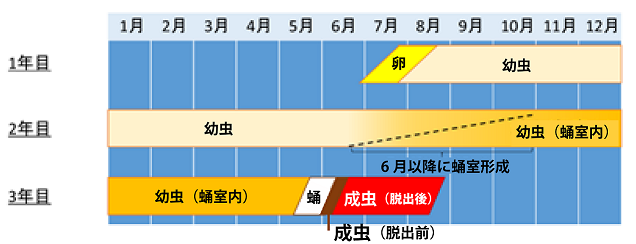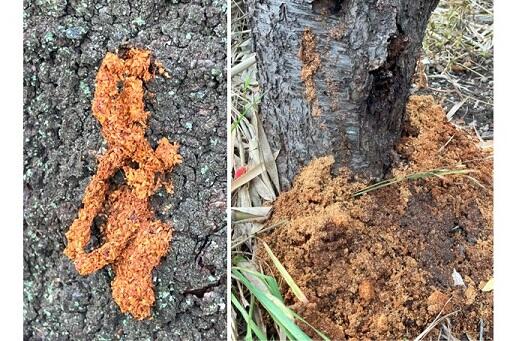(This is an English translation of the original Japanese article.
The publication date refers to that of the Japanese version,
which differs from the upload date of the English version.)
The red-necked longhorn beetle is an invasive insect that damages Rosaceae trees such as cherry, peach, and plum. The larvae feed under the bark of the trees, causing them to wither and die in severe cases (Photo 1). A research group consisting of 11 institutions, led by the Forestry and Forest Products Research Institute, spent four years from 2018 studying the ecology, life cycle, effective pesticides, and control methods of the red-necked longhorn beetle, which was previously unknown in Japan. They compiled a manual on how to control the damage by taking appropriate measures at the right time. By utilizing this manual, it is expected that the beautiful scenery of cherry blossoms in spring, as well as fruit trees such as peach and plum, can be protected.

Photo 1: Larvae of the red-necked longhorn beetle hiding in the trunk of a dead peach tree. The hole in the trunk is a mark left by larvae. (provided by the Forestry and Forest Products Research Institute)
What is the red-necked longhorn beetle?
The red-necked longhorn beetle is originally found in China, Mongolia, the Korean Peninsula, and Vietnam. It is with a shiny black body that is two to four centimeters in length and has a distinctive red back on its anterior chest, which looks like a neck (Photo 2). In China, it is known as a pest of peach trees. The eggs are laid in the cracks of the bark and the hatched larvae feed on the inside of the tree, sometimes causing it to die. A single female can lay over 1,000 eggs and has strong reproductive power.
In Japan, the beetle was first confirmed to have invaded Saitama Prefecture in 2011. In 2012, damage was first detected on cherry trees in Aichi Prefecture. It has since been found in 13 prefectures including Ibaraki, Tochigi, Gunma, Tokyo, Kanagawa, Mie, Osaka, Nara, Wakayama, Hyogo, and Tokushima. In 2018, it was designated as an "invasive alien species" that could potentially harm ecosystems, human life and health, and agriculture, forestry and fisheries.

Photo 2: Imago female (under) and male (over)
Disclosure of pest control methods and development of information sharing system
The research group has revealed that, in a previously unknown life cycle in Japan, larvae of red-necked longhorn beetle spend about two years inside trees before becoming pupae and emerge as imagoes between June and August (Figure 1).
In addition, while damage from the beetle initially spread among 'Somei-Yoshino' and other cherry trees, subsequent research showed that they prefer peach trees over cherry trees. The research group has spent four years and compiled a pest control manual "Red-necked Longhorn Beetle Extermination Method," including the revealed ecology and extermination methods of the beetle. It is available on the website of the Forestry and Forest Products Research Institute.
https://www.ffpri.affrc.go.jp/pubs/chukiseika/documents/5th-chuukiseika12.pdf
The manual introduces control methods tailored to the damage situation and life cycle of the pest, such as physical extermination through tree felling and larva/imago capture, as well as chemical extermination using effective agents, with the expectation of their practical application. In addition, the research group has developed and launched a real-time online mapping system that allows for sharing damage information among multiple affected areas. If someone discovers damage and reports it via their smartphone or PC to the damage survey website (https://kubiaka.jp/home/), such information will be accumulated in the system. Anyone can access the data, sorted by region or date, on this website, and local government officials can also use it to create maps to better understand the extent of the damage.

Figure 1: Life cycle of red-necked longhorn beetles in a peach orchard in Tochigi Prefecture (two-year cycle: hatching two years after spawning) (provided by the Forestry and Forest Products Research Institute)
Larval excreta provide clues to discovery
According to the research group, early detection and extermination are crucial in controlling red-necked longhorn beetles. The larvae of the pest excrete a mixture of feces and sawdust called "frass" after eating wood. When they invade into trees by creating tunnels inside, they push out the frass that gets in their way through excretion holes they have opened on the surface of the tree in a thin, connected shape about 2-8mm in diameter, which accumulates at the base of the tree (Photo 3). This is an important clue for finding damaged ones.
It is important to regularly check the trunks and bases of cherry and peach trees for traces of frass. They can be seen from spring to autumn, but are found in many trees particularly during hot summer months, so if you check them only once a year, it would be most efficient to do it after the Obon holiday (a traditional Japanese holiday honoring the spirits of ancestors in mid-August).

Photo 3: A row of frass pushed out from the excretory hole by the larvae of the red-necked longhorn beetle (left), a large amount of frass accumulated at the base of the tree (right)
Requires cooperation from many people
The representative of the research group, Etsuko Kagaya at the Forestry and Forest Products Research Institute, says, "It is important for the administrative agencies, local governments, orchard owners, and general citizens to work together in the community to find and exterminate red-necked longhorn beetles." After having read this story, please be mindful of the frass when walking near cherry, peach, or plum trees. If you find them, please report them to the damage survey site (https://kubiaka.jp/home/)or contact your local government.
※The information on the original habitat of the red-necked longhorn beetle was based on
the Invasive Species Database of the National Institute for Environmental Studies.
https://www.nies.go.jp/biodiversity/invasive/DB/detail/60560.html
Project name
Research Program on Development of Innovative Technology (Development Research Stage)
Project period
FY2018 to 2021
Title
Development of Control Methods for the Red-necked Longhorn Beetle, an Invasive Species that Damages Rosaceae Trees such as Cherry, Peach, and Plum
Leading research institutes
Forest Research and Management Organization (representative institution), Tokushima Agriculture, Forestry and Fisheries Technology Support Center, Tochigi Prefecture National Agricultural Experimental Station, Research Institute of Environment, Agriculture and Fisheries of Osaka Prefecture, Nihon University, Institute for Plant Protection of National Agriculture and Food Research Organization, Ecosystem Conservation Society-Saitama, MapQuest Corporation, Wakayama Prefecture, Aichi Forestry Research Institute , Dainihon Jochugiku Co., Ltd.
This research project was applied to BRAIN's "Research Program on Development of Innovative Technology" by the "Coordination, Research and Development Platform for Biological Damage to Trees," which was organized in the "Field for Knowledge Integration and Innovation," a mechanism for interdisciplinary fusion and industry-academic collaboration operated by the Ministry of Agriculture, Forestry and Fisheries.
URL for "Field for Knowledge Integration and Innovation"
https://www.knowledge.maff.go.jp/en/fkii.html
